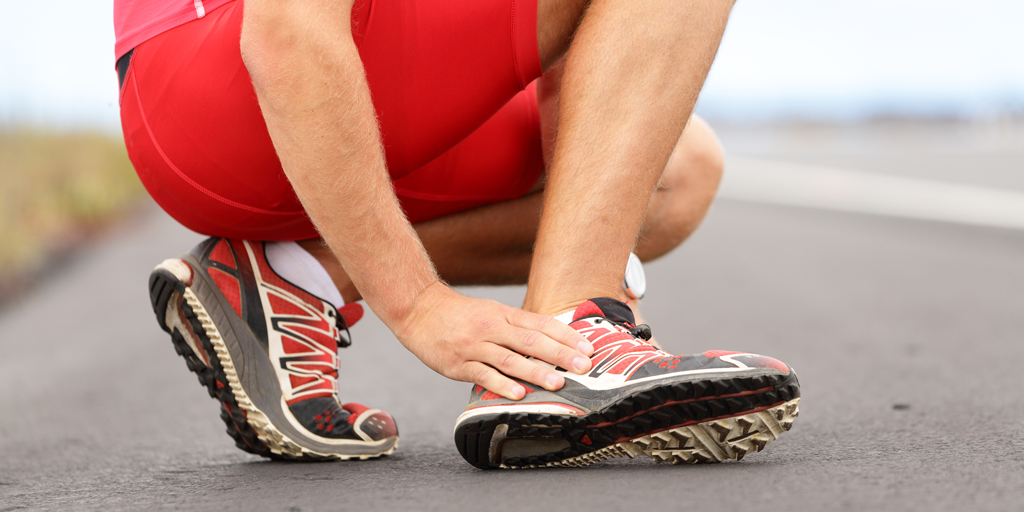5 Most Common Running Injuries

These common running injuries can affect everyone, from the newbie runner to the grizzled veteran. Not surprisingly, all involve the lower extremity near the knee and down. Each can be affected by the biomechanics of the foot and ankle, but also influenced by the movement of the hip and thigh, which can impact the tissue further down.
Plantar Fasciitis
Plantar fasciitis is pain under the bottom of your foot and towards the heel. Sufferers usually dread their first few steps in the morning or after sitting for any length of time.
Therapy includes rest, rolling a frozen water bottle or lacrosse/golf ball, exercises to strengthen the foot and lower extremity muscles such as simple balance tasks while trying to maintain an arch. You may require insoles or custom orthotics.
Achilles Tendonopathy (Tendinitis)
Achilles Tendonopathy is described as pain at the back of the lower leg can be close to the heel. Aggravated with running, and can be stiff and tight after sitting for some time. Treatment includes: rest, soft tissue release for the calf muscles, addressing any biomechanical issues/footwear.
You should include an exercise similar to a reverse calf raise. Use assistance from your arms to go up on your toes, shift body weight to the injured side, slowly lowering back down with little to no help from your arms. Begin with one set of 15 repetitions, increasing over weeks to three sets. Progress training slowly on return to running.
Medial Tibial Stress Syndrome (Shin Splints)
Shin Splints are categorized as pain along the front and inner shin that becomes worse with activity. Often related to a change in training or footwear, and influenced by biomechanics of the foot and ankle. Rest, ice cups applied directly to the shin can help with the pain.
Assessing footwear and foot/ankle biomechanics is essential. Persistent pain may require x-ray/bone scan to rule out a stress fracture.
Patellofemoral Pain Syndrome (Runner’s Knee)
Patellofemoral Pain Syndrome is categorized as pain behind or on the outer side of the kneecap. Discomfort with sitting for extended periods (i.e. at movie or driving). Related to improper movement of the kneecap in its ‘groove’ at the end of the femur. Causes include tight outer thigh musculature that can pull the patellae slightly to the side as you run or walk.
Weakness in the muscles at the sides of your hips can also contribute, allowing the legs to collapse slightly into a knock-kneed position. Further, biomechanical issues such as overpronation (causing the tibia to rotate inwards) can also affect the tracking of the kneecap.
Treatment can incorporate soft tissue treatment to the outer leg musculature, strengthening hip abductors and quadriceps and addressing biomechanical issues contributing to overpronation. Taping the kneecap can sometimes help.
Iliotibial Band (ITB) Friction Syndrome
IBT Friction Syndrome is pain and irritation on the outer thigh, just above the knee. Can be related to tightness/weakness in outer hip and thigh musculature, increasing tension at the bottom of the ITB.
As a result, there is friction against the end of the femur, just above the knee. Pain tends to be worst while slightly bending knee such as going up and down stairs. Therapy involves releasing outer thigh musculature (rolling pin, foam roller), strengthening hip abductors and including some cross training that involves some side to side direction rather than just linear movement can also be helpful.
Talk To An Expert!
The above information is simple examples of symptoms of common running injuries and their associated treatments. The best course is for your trusted health care provider to assess any injury, and to have the professionals at Kintec observe and analyze your running/walking gait.
Kevin Lunnie, B Sc., DC
Certified Provider of Active Release Techniques®
Graston Techniques Level 1 Certified
Sorry, the comment form is closed at this time.